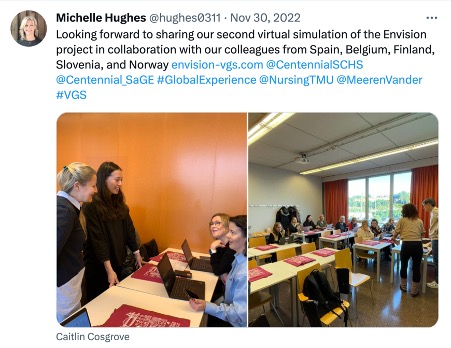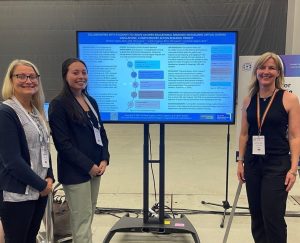Dissemination: Conference and Publications
Once your research has been completed, you want to showcase your work and share your findings with a wider audience.
Ask yourself the following questions:
- Who is your audience?
- Where can your audience be found?
- How can you best reach your audience?
Your audience may include members of your professional community, as well as other educators who are studying similar research topics and have a shared interest in your work. Disseminating your research findings nationally and internationally through informal discussions, institutional presentations, conferences, and publications can expand your networking community and increase future collaboration opportunities.
At Centennial College, an annual event celebrating research, innovation, scholarship, and entrepreneurship (RISES) provides an opportunity for educators to present their research to the college community. Educators also have opportunities to discuss their research through a variety of rich and diverse informal sessions at a weekly research networking group.
The Centennial Research Networking group consists of researchers, practitioners, scholars, and Ph.D. candidates from inside and outside the college community. The group share their work and insights and receive informal feedback which can assist them not only with their research ideas and methodologies but also further preparation for more formal presentations at conferences and future publications of their work.
Within nursing, there are several conferences where your virtual simulation research could be showcased. Below is a list of some organizations to explore:
 In today’s world of digital technology, online presentations, webinars, or social media platforms such as blogging or creating your own website may be utilized to share your work. Communicating your research through written publications such as academic journals is another important dissemination process.
In today’s world of digital technology, online presentations, webinars, or social media platforms such as blogging or creating your own website may be utilized to share your work. Communicating your research through written publications such as academic journals is another important dissemination process.
Journals selected by researchers may be open access or specific to the particular topic of study. It is important to always be aware of predatory journals — those journals that state they are scholarly but do not have rigorous peer review and editorial practices (Elmore & Weston, 2020). When choosing an appropriate scholarly peer-reviewed journal, the following websites may assist you with this process:
Sharing your Virtual Simulations
When sharing your research for your virtual simulation, remember to consider the following:
- Know your audience.
- Connect with them through various platforms, such as conferences, publications, social media, your own website, or informal discussions.
- Be visible through social media and academic networking.
- Display your work in visually pleasing ways to attract attention.
- Encourage participation and collaboration by inviting others to openly engage in discussions about your research.
To ensure your research is finding the right audience and your written work is being considered for publication, it is important to submit your work to credible journals and not predatory journals.
This short video provides an overview and tips to avoid predatory journal submissions:
What is a predatory journal and why is it a problem? Tips to avoid them
Insights from the Student Team
Submitting your research to a conference will allow you to disseminate your virtual simulation and network with other experts in the field.
For one of our virtual gaming simulations, the team submitted an abstract to the 2013 International Council of Nurses Conference in Montreal, Canada.
This was a great learning opportunity to help write the script and provide feedback from a student perspective.
Video: A Student Perspective: Creating a Meal Assistance Virtual Gaming Simulation (CASN presentation 2021)
More recently, some of our team members presented a poster on the development of this OER at the International Council of Nurses Congress in Montreal 2023


Attribution
Content from this page was re-organized into a table, remixed with our own original content, and adapted from: (with editorial changes)
Research Methods in Psychology by Paul C. Price, Rajiv Jhangiani, & I-Chant A. Chiang is licensed under a Creative Commons Attribution-NonCommercial-ShareAlike 4.0 International License, except where otherwise noted.
Research Methods for the Social Sciences: An Introduction by Valerie Sheppard is licensed under a Creative Commons Attribution-NonCommercial-ShareAlike 4.0 International License, except where otherwise noted.
Using Virtual Gaming Simulation: An Educator’s Guide by Margaret Verkuyl, Sandy Goldsworthy, and Lynda Atack is licensed under a Creative Commons Attribution 4.0 International License, except where otherwise noted.
Virtual Simulation: An Educator’s Toolkit by Centennial College is licensed under a Creative Commons Attribution-NonCommercial 4.0 International License, except where otherwise noted.
References
Elmore, S.A. & Weston, E.H. (2020). Predatory journals: What they are and how to avoid them. Toxicologic Pathology, 48(4) 607–610 https://doi.org/10.1177%2F0192623320920209
Ross-Hellauer T., Tennant J. P. , Banelytė, V., Gorogh, E., Luzi, D., Kraker, P., et al. (2020). Ten simple rules for innovative dissemination of research. PLoS Computational Biology, 16(4): e1007704. https://doi.org/10.1371/journal.pcbi.1007704

